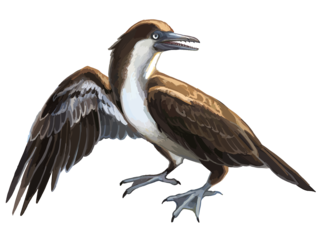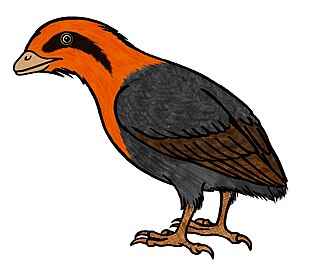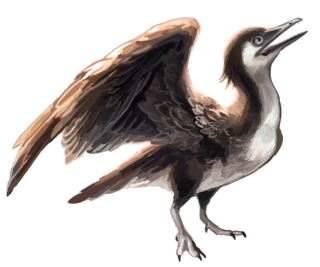
Caudipteryx is a genus of small oviraptorosaur dinosaurs that lived in Asia during the Early Cretaceous, around 124.6 million years ago. They were feathered and extremely birdlike in their overall appearance, to the point that some paleontologists suggested it was a bird. Two species have been described: C. zoui, in 1998, and C. dongi, in 2000.

Confuciusornis is a genus of basal crow-sized avialan from the Early Cretaceous Period of the Yixian and Jiufotang Formations of China, dating from 125 to 120 million years ago. Like modern birds, Confuciusornis had a toothless beak, but closer and later relatives of modern birds such as Hesperornis and Ichthyornis were toothed, indicating that the loss of teeth occurred convergently in Confuciusornis and living birds. It was thought to be the oldest known bird to have a beak, though this title now belongs to an earlier relative Eoconfuciusornis. It was named after the Chinese moral philosopher Confucius. Confuciusornis is one of the most abundant vertebrates found in the Yixian Formation, and several hundred complete specimens have been found.

Yanornis is an extinct genus of fish-eating Early Cretaceous birds. Two species have been described, both from Liaoning province, China: Yanornis martini, based on several fossils found in the 120-million-year-old Jiufotang Formation at Chaoyang, and Yanornis guozhangi, from the 124-million-year-old Yixian Formation.

Caudipteridae is a family of oviraptorosaurian dinosaurs known from the Early Cretaceous of China. Found in the Yixian and Jiufotang Formations, the group existed between 125 and 120 million years ago. Distinguishing characteristics of this group have been indicated as including a unique dagger-shaped pygostyle. In 2015, the group was defined as "the most inclusive clade containing Caudipteryx zoui but not Oviraptor philoceratops and Caenagnathus collinsi".

Gansus is a genus of aquatic birds that lived during the Aptian age of the Early Cretaceous (Aptian-Albian) period in what are now Gansu and Liaoning provinces, western China. The rock layers from which their fossils have been recovered are dated to 120 million years ago. It was first described in 1984 on the basis of an isolated left leg. It is the oldest-known member of the Ornithurae, the group which includes modern birds (Neornithes) and extinct related groups, such as Ichthyornis and Hesperornithes.

Confuciusornithidae is an extinct family of pygostylian avialans known from the Early Cretaceous, found in northern China. They are commonly placed as a sister group to Ornithothoraces, a group that contains all extant birds along with their closest extinct relatives. Confuciusornithidae contains four genera, possessing both shafted and non-shafted (downy) feathers. They are also noted for their distinctive pair of ribbon-like tail feathers of disputed function.
Largirostrornis is a genus of enantiornithean bird. One species has been named, Largirostornis sexdentoris. It lived during the Early Cretaceous and is known from fossils found in the Jiufotang Formation in Liaoning province, People's Republic of China. Some researchers believe this species to be a junior synonym of the similar Cathayornis yandica.

Longirostravis is a genus of enantiornithean birds which existed during the early Cretaceous period and is known from fossils found in the middle or upper Yixian Formation in Yixian County, People's Republic of China. It is known from a single specimen housed in the collections of the Institute of Vertebrate Paleontology and Paleoanthropology representing the type species Longirostravis hani.

Liaoningornis is a genus of bird from Lower Cretaceous China. It was collected from the dinosaur-bearing beds of the Sihetun locality, of the Yixian Formation, Shangyuan, near the city of Beipiao in Liaoning province. The only known species is Liaoningornis longidigitris. It was described by Linhai Hou in 1996 and 1997.
The Jiufotang Formation is an Early Cretaceous geological formation in Chaoyang, Liaoning which has yielded fossils of feathered dinosaurs, primitive birds, pterosaurs, and other organisms. It is a member of the Jehol group. The exact age of the Jiufotang has been debated for years, with estimates ranging from the Late Jurassic to the Early Cretaceous. New uranium-lead dates reveal the formation is deposited in the Aptian stage of the Early Cretaceous. Fossils of Microraptor and Jeholornis are from the Jiufotang.
Paraprotopteryx is a genus of enantiornithean birds from the Mesozoic of China.

Similicaudipteryx, meaning "similar to Caudipteryx", is a genus of theropod dinosaur of the family Caudipteridae.

The Yixian Formation is a geological formation in Jinzhou, Liaoning, People's Republic of China, that spans about 1.6 million years during the early Cretaceous period. It is known for its fossils, listed below.
Longicrusavis is an extinct genus of basal ornithuromorph bird found only at Dawangzhangzi village in Liaoning Province, China. Longicrusavis was a ground dwelling carnivore, a wader, and part of biological family Hongshanornithidae, considered to have been a dominant species in the Jehol Biota, the prehistoric Chinese ecosystem which supported them. The name Hongshanornithidae represents one of China's oldest recorded cultures in the region, the Hongshan culture.
Hongshanornithidae is an extinct group of early ornithuromorph birds from the early Cretaceous period of China. It includes the genera Hongshanornis and Tianyuornis from the Yixian Formation of Inner Mongolia, Longicrusavis from the Yixian Formation of Liaoning Province, Parahongshanornis from the Jiufotang Formation of Liaoning Province, and Archaeornithura, the oldest known member, from the Huajiying Formation of Hebei Province.
Dalingheornis is a genus of enantiornithean birds which lived during the early Cretaceous period, about 122 Ma ago, and are known from a single juvenile fossil found in the upper part of the Yixian Formation at Dawangzhangzi, Liaoning province, People's Republic of China. It is the first known Mesozoic bird with heterodactyl feet specifically adapted for climbing, and was probably among the most arboreal of the enantiornithines. Unlike its relatives, it had an unusually long (17mm) skeletal tail made up of 20 vertebrae, similar to the tails of dromaeosaurids. However, this may have been a juvenile feature. The fossil was named after Yang Liwei, the first Chinese astronaut in space.

Songlingornithidae is a family of basal euornitheans from the Early Cretaceous of China. All known specimens come from the Jiufotang Formation and the Yixian Formation, dating to the early Barremian and Aptian ages, 125–120 million years ago.

Yanornithiformes is an order of ornithuromorph birds from the early Cretaceous Period of China. All known specimens come from the Yixian Formation and Jiufotang Formation, dating to the early Aptian age, 124.6 to 120 million years ago.

Bohaiornis is a genus of enantiornithean birds. Fossils have been found from the Lower Cretaceous Jiufotang Formation of western Liaoning, China. The only known species, Bohaiornis guoi, was named by Dongyu Hu, Li Li, Lianhaim Hou and Xing Xu in 2011 on the basis of a fully articulated and well-preserved skeleton of a sub-adult. This specimen, LPM B00167, preserved two long, ribbon-like feathers attached to the tail rather than a fan of shorter pennaceous feathers. It was similar to the slightly older Eoenantiornis, but much larger in size. Bohaiornis is the type species of Bohaiornithidae, a family of large predatory enantiornitheans from the Early Cretaceous.















